
Have You Ever Noticed A Half-Moon Shape On Your Nails? Check Out What It Say About Your Health
Living beings especially human beings have hundreds of delicate ways to send us messages about our health. Things like the color of our skin, how quickly wounds heal, and acne can all signal nutrient status, how much our hair falls out, potential food intolerances, the state of our microbiome, and even serious diseases such as diabetes or cancer.

There is one area of our bodies that most of us never give a second thought of, can actually provide you with a lot of valuable information about your health. And that is the white half-moon on your fingernails which is called Lunula.
What Is The Lunula?
The lunula, or lunulae, is the crescent-shaped whitish area of the bed of a fingernail or toenail. The lunula is the visible part of the root of the nail. In humans, it appears by week 14 of gestation and has a primary structural role in defining the free edge of the distal nail plate (the part of the nail that grows outward).
It looks like it is part of your nail but sits on top of the skin just underneath your nail. It is a protective covering of the otherwise vulnerable blood vessels found there. It is proved that everyone has a lunula, though it is not always visible on all fingers. Lunula plays a big role in the shape of your fingernails and how they grow, any damage to it can forever change how your nail grows, if at all.
What Does Lunula Mean For Your Health?
According to a study published in the 1996 Journal of the Academy of Dermatology, the lunula has three ways it warns you of potential health problems: Through its size, shape, and color. A normal, healthy lunula is half-moon shaped, ivory, and takes up about a 5th of your nail. If you notice any of the following changes to your lunula, you may want to make an appointment with your doctor or health care practitioner.
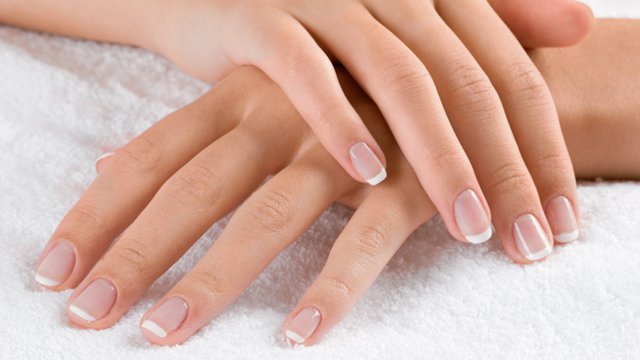
If the lunula only appears on the thumbs, it indicates that the physical energy is insufficient and the disease is about to come. Other factors shall also be considered comprehensively in judging whether a person is suffering from the certain disease, and there is no need to be panic about the change of lunula since the confirmation of a disease requires many inspections.
Appearance:
It is located at the end of the nail (that is closest to the skin of the finger), but it still lies under the nail. It is not actually white but only appears so when it is seen through the nail. Outlining the nail matrix, the lunula is a very delicate part of the nail structure. If one damages the lunula, the nail will be permanently deformed.
Even when the totality of the nail is removed, the lunula remains in place and is similar in appearance to another smaller fingernail embedded in the nail bed. In most cases, it is half-moon-shaped and has unique histologic features. Examinations concluded that the lunula was an area of loose dermis with lesser developed collagen bundles. It appears whitish because a thickened underlying stratum basale obscures the underlying blood vessels.
Lunula Size:
The more energetic a person is, the whiter the lunula is; on the contrary, the lunula is poor and vague. In general, the lunula takes an area of about one fifth of the fingernail and has the clear edge. The lunula usually tells the disease of a person in the form of color change or disappearing crescent.
- Macrolunula: This is when the lunula is bigger or enlarged. For some ethnicities, particularly those of Indian descent, this is normal. Otherwise, it can signify endocrine disorders such as hyperthyroidism.
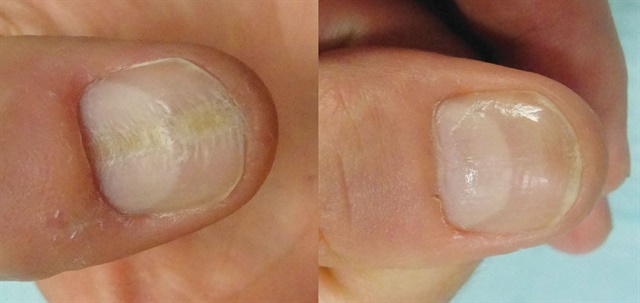
- Microlunula And Anolunula: This is when the lunula is either small or absent altogether. While a microlunula is usually normal for people of African descent and can simply be age-related, it can also signify other problems.
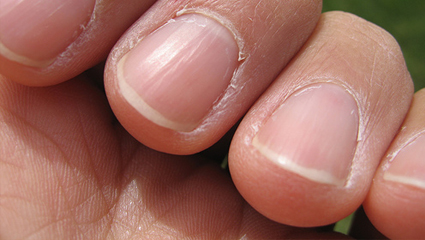
Lunula Tells The Health Of Human Body:
Normal Conditions:
1. Quantity: It would be better to have 8 to 10 lunulas on both hands;
2. Shape: It would be better to take an area of one fifth of the fingernail;
3. Color: It would be better in the color of ivory. The whiter, the better, which indicates the person is stronger.
Abnormal Conditions:
The development of the lunula is affected by nutrition, environment, and physical quality. When the digestion and absorption function is poor, the lunula dims, reduces, even disappears. The big lunula indicates the rapid blood circulation while the small lunula indicates the poor blood circulation; the lunula disappears under the condition of severe anemia. The less lunula a person has, the lower energy, colder constitution and weaker immunity he/she has, so his/her body, feet and hands are always cold.
Lunula Color:
Black: Usually indicates the severe heart disease, cancer or drug poisoning and heavy metal poisoning out of the long-term medication.
Red Spots: A red spotted lunula could mean alopecia, areata, vitiligo, or psoriasis. It could also signify nail dystrophy and deformity diseases.
Pink: The same color with the fingernail indicates the decline of visceral functions and the over consumption of physical strength, which is easy to cause diabetes, hyperthyroidism and other diseases.
Yellow: Yellow lunulas are most often caused by exposure to insecticides and pesticides.
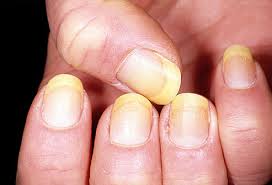
Grey: Low energy, which affects the operation of the spleen, stomach, digestion and absorption and it is easy to cause anemia and feel tired;
Blue: This is often caused by systematic drug ingestion, including Exlax, chemotherapy drugs, and other cancer and HIV drugs. A blue lunula has also been connected with Wilson’s disease and Hemoglobin M disease.
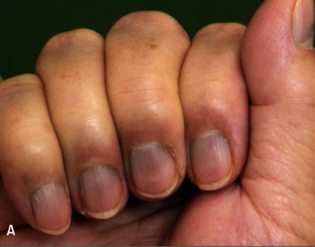
White: While your lunula should appear whiter than the rest of your nail, extremely white lunulas can mean trouble. Also known as Leukonychia, this is often seen in those with chronic renal failure, nephrotic syndrome, cirrhosis, congestive heart failure, and diabetes.
Ivory: Normal, this kind of people are energetic, strong and healthy;
Purple: It is easy to cause the poor blood circulation of heart and cerebral vessels, the insufficient blood and oxygen supply, dizziness, headache and cerebral arteriosclerosis.
Moons On The Five Fingers:
Thumb Finger: It is related with lung and spleen. The pink color indicates the pancreatic dysfunction and it is easy to catch a cold and feel tired repeatedly, even have diabetes.
Index Finger: It is related with intestines and stomach. The pink color indicates the poor circulation of the stomach and large intestine, so the appetite decreases naturally.
Middle Finger: It is related with pericardium channel and consciousness. The pink color indicates the psychentonia and it is easy to cause dizziness, headache, unbalanced consciousness, insomnia and dreaminess.
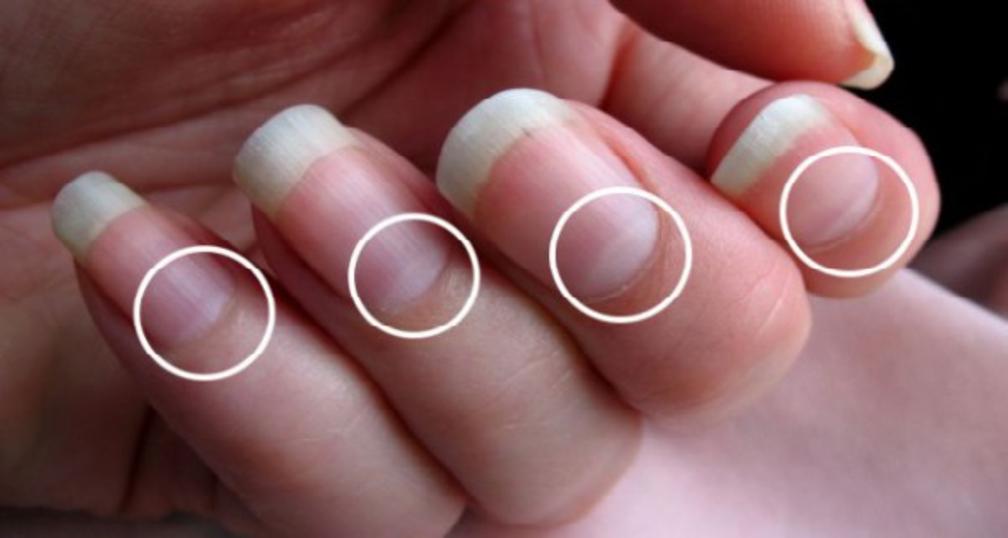
Ring Finger: It is related with internal secretion. The pink color indicates that the triple energizer meridian in the ring finger is abnormal and it is easy to cause the constitutional decline and yin-yang disharmony with an ineffable discomfort. Women of this kind always have the gynecological diseases like irregular menstruation.
Little Finger: It is related with heart and kidney. Generally, the lunula is unlikely to appear on this finger and when it appears, it implies the fever. The red color indicates the serious heart disease.
This is how half-moon shape on your nails reveal a lot about your health. If you notice that your lunula has any of the above characteristics, don’t worry, check to see if you have any other symptoms of any of the mentioned diseases, and make an appointment with your doctor to talk about your concerns and have a check-up.